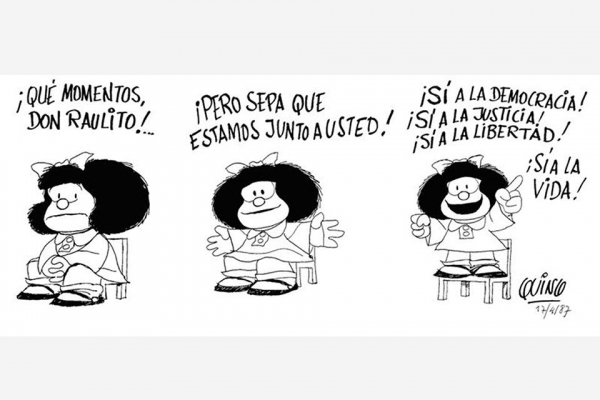Social processes in the eyes of Mafalda

Isabella Cosse is the author of a reference book on Quino's work, and for this reason she was invited to participate in a recent volume published in Madrid.
Mafalda is always read. The semantic layers that Quino's masterpiece accumulates complement and branch out. Inside and outside of the country. Fascinating aspects that show the creative genius of the Mendoza humorist, but also the ruse and professionalism with which its editors promoted the strip in other geographies and cultures. Along this path runs the essay that the researcher and teacher Isabella Cosse (Conicet, UBA) includes in Cómics y memoria en América Latina, a recent volume edited by Cátedra (Madrid), with an editing task in charge of Jorge L. Catalá Carrasco, Paulo Drinot and James Scorer. "The comic has had a central place in Latin American social and political processes, and especially in certain situations in relation to memory. This is a book that accounts for this breadth and complexity," says Cosse, whose book Mafalda: historia social and political (FCE, 2014) knows these days an English translation by Duke University Press.
The genesis of Comics and Memory in Latin America arises from a call made in England. Those days gave rise to a book, of which the Chair is its translation into Spanish. Something that might be curious, but nevertheless it is not so curious. Since the interest in Latin American comics - and specifically Argentina - is long-standing. Needless to say about the link between local and international comics had to happen early. Cosse chooses, among other examples, that of the Italian César Civita, “one of the most important producers of comics in the country, owner of the Abril emporium. He came fleeing the war and was a very effervescent pole of editorial production. In addition, at the time of the boom of comic books and graphic humor, during the '60s and' 70s, in Argentina cartoonists and authors dialogued from their own creation with the trends of the comic at an international level ”.
- In that context, Mafalda appears precisely.
As I began to deal with Mafalda , I realized that there was an international, transnational dimension. It is perhaps the best known and most widely read Latin American comic, and that dimension had to be accounted for. That was a two-pronged job. On the one hand, knowing how Mafalda got to different places; and in turn, if success was possible, it was because Mafalda acquired new meanings in each of those places. Italy was the gateway, following an editor and journalist, Marcelo Ravoni, who had had to leave because of the Onganía dictatorship. He summoned Quino for a first publication, with a selection of strips. There was a clipping there that could potentially be of interest. This happens in 1968, and Ravoni highlights the issues related to repression, student mobilization, politicization, sexuality and new parenting methods, which greatly involved the situation at that time, the working classes, the classes. media, students and young people in Italy. I think this possibility of appropriating Mafalda is provided especially by Quino's drawing and conceptual creation, but also by the work done by editors and journalists, favoring some readings more than others. It is very curious that in Spain, during the Franco regime, when Mafalda had many resonances in relation to repression and reading between the lines, a magazine that sought to become the reference in Spanish-speaking comics, as was El Globo , had it like your pet. In the first issue (March 1973) she is on the cover and is the figure that opens the readers and editorial comments.
--Even when Quino stopped drawing Mafalda in 1973, he still continued it with occasional illustrations and statements; in this sense, his reference to Mafalda as one of the 30 thousand disappeared is relevant.
-Quino says goodbye to Mafalda but Mafalda , due to her own dynamism, demands him, and this scares him and favors him at a certain point. At the time of the democratic restoration, a kind of intervention by Quino took place around the possibility of thinking of Mafalda as an expression of the generation of the 1960s, and a kind of collective game took place, in which different voices intervened. There is a very important element that is this possibility of thinking of Mafalda as a disappeared person at a time of great significance, of public discussion, of the installation of the human rights agenda. It is not by chance that this has happened, Mafalda was a way to bring the tragedy of the disappeared closer to Argentine society as a whole, and at that moment it plays a role in social memory, of a first approach, processing and reading, about the generation of the '60s and their political commitment.
Mafalda was a way to bring the tragedy of the disappeared closer to Argentine society as a whole
--Even when Quino stopped drawing Mafalda in 1973, he still continued it with occasional illustrations and statements; in this sense, his reference to Mafalda as one of the 30 thousand disappeared is relevant.
-Quino says goodbye to Mafalda but Mafalda , due to her own dynamism, demands him, and this scares him and favors him at a certain point. At the time of the democratic restoration, a kind of intervention by Quino took place around the possibility of thinking of Mafalda as an expression of the generation of the 1960s, and a kind of collective game took place, in which different voices intervened. There is a very important element that is this possibility of thinking of Mafalda as a disappeared person at a time of great significance, of public discussion, of the installation of the human rights agenda. It is not by chance that this has happened, Mafalda was a way to bring the tragedy of the disappeared closer to Argentine society as a whole, and at that moment it plays a role in social memory, of a first approach, processing and reading, about the generation of the '60s and their political commitment.
Mafalda was a way to bring the tragedy of the disappeared closer to Argentine society as a whole- Also support for Alfonsín during the events of Holy Week
-At that time, there is a discussion between humorists and in the artistic field about the role of humor in relation to politics. Quino makes a kind of self-criticism, in relation to the role that humor had played with the fall of Illia. His caricature as a turtle is well known, something that had driven and expressed a critical spirit that became, because of course a cartoon does not explain the coup, but it does account for a state of public opinion in which humor participated. Quino is very critical, and at that moment he decides to make a decision with a very determined commitment in support of democracy when the Carapintadas uprisings occur. Send a Mafalda congratulating and supporting Alfonsín. That was one of Quino's clearest and most significant political interventions with Mafalda .
Posted by Pagina / 12







